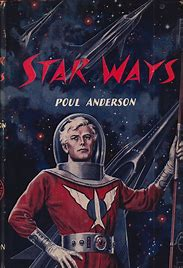Robert Heinlein presents three accounts of early interstellar travel -
in his Future History, Orphans Of The Sky, a first interstellar expedition (spaceship Vanguard);
in his Future History, Methuselah's Children, a first interstellar round trip, developing FTL en route (spaceship New Horizons);
in his Juvenile Future History, Time For The Stars, a first interstellar round trip, developing FTL en route (first spaceship Avant-Garde.)
James Blish has two first interstellar journeys:
FTL round trip to Proxima Centauri in "Common Time";
STL one-way trip to Beta Sol in "Darkside Crossing."
Poul Anderson's works do not feature a first interplanetary or a first interstellar journey as far as I know.
However, interstellar sf can mean narratives with a background of regular FTL travel in an interstellar civilization. Such civilizations emerge in Anderson's Psychotechnic and Technic Histories and also exist in one-off works like After Doomsday and World Without Stars. Heinlein's juvenile novels with this kind of background are The Star Beast, Starman Jones, Starship Troopers and Citizen Of The Galaxy. "Stars" is a much used word. We have since had Star Trek and Star Wars and Anderson's Psychotechnic History includes Star Ways.
Although interstellar distances allow a lot of space for different things to happen, these works do not usually form a consistent series because they diverge in details like the means of FTL used and the course of future historical events.

1 comment:
Kaor, Paul!
I think we do see Anderson giving us first interplanetary/interstellar journeys in "Murphy's Hall." Albeit that was one of his grimmer, more dystopian stories.
Ad astra! Sean
Post a Comment